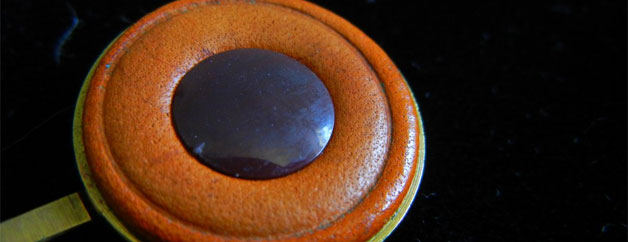Ask a Saxophone Repairman: Should I Repad?
 This post is part of a special column titled “Ask a Saxophone Repairman” with answers supplied by our resident repair whiz, Matt Stohrer of Stohrer Music.
This post is part of a special column titled “Ask a Saxophone Repairman” with answers supplied by our resident repair whiz, Matt Stohrer of Stohrer Music.
Disclaimer: Saxophone repair is a complicated business, depending not only on the skill of the repairer but on the reality of the situation at hand. The advice given here is given without your horn in my hands, so take everything I say with a grain of salt, and take it upon yourself to get more opinions and form your own conclusions. This column is not a substitute for finding a great saxophone repairman and building a relationship- instead it should be viewed as a resource to be used so that you can know more about your horn and become a smarter consumer and a better saxophonist.
This week’s question:
Hi there,
Thanks so much for lending your time to the site.My question concerns pads leaks and repairs. I am not a “do it-yourself-er” and I wish I was. Not all my pads need to be changed, but I know three or four could do with a repad. My repairman says that it’s better to do a complete repad than to do a bunch of one-off jobs because of alignment and other factors which can effect thee horn’s overall performance. Also the price of one or two pads does not compare when I take into account the labor costs.With all that said, should I wait or should I seek another repair guy?
Nemoy
Thanks for writing!
Second and third opinions are always wise if you do not yet have a relationship of trust with your repairman. But there are very real reasons that a repairman would recommend a full repad over a smaller job. I will attempt to explain them.
Now I’m a long winded guy anyways, but this deserves a full answer because the issue you are lighting upon is a big one, and can be the source of misunderstanding that tarnishes what would otherwise be positive development for you and your horn. So let’s dive in…
Regarding padwork- many of the keys are connected to each other, moving in sync. You won’t understand much of what I’m about to say unless you understand what I mean here, so take your horn out, and press the keys on the horn one by one and watch how many of them move together, and follow these linkages to understand how they work and interact.
Ok, done that? Seriously, stop reading and go do it.
Kind of cool, right? Lots of stuff going on there.
Ok, back to business.
Everything’s Connected
If I replace your F# key (the one without a pearl that is above the F key on the right hand/lower stack), I have to make sure it is in adjustment with the rest of the lower stack- that when the F closes, it also closes the F# pad perfectly, same for the E (which is how you finger F#), and D. Not only to they have to close at exactly the same time (if not you’ll have a leak), the heights of the F-E-D must be aligned so that when you press the F, E, or D, there is no lost motion and the F# key moves in perfect sync as soon as you apply pressure to any of the lower stack keys (if not it will feel like garbage). For the F# in particular, I also have to make sure that the G#/bis adjustments (used to keep the G# closed while fingering bell key bottom-most notes, and for the 1+1 Bb fingering respectively) are perfect as well. Modifying any of these adjustments can involve adjusting or completely redoing the existing adjustment materials, depending on the particular instrument involved and how it is set up.
I tend to redo adjustment materials. It is not often that I find that the current materials on the horn are what I would consider the best or most long-lasting, so I usually replace them.
So then I just replaced your F#, all is well. But, if you come back a month later to do your F, I have to make sure it is in adjustment with the rest of the lower stack- just like before. If you come back a month later and get your E done….and a month later to get your D done – you get the picture. Whereas if I do the whole stack at once, I seat the pads, then make sure they are all in adjustment with each other. This means less time overall for the same end result which equals less money spent in the long run. Not to mention better results since all the pads are the same age and if they change or settle over time they should do it in a similar way.
Note: there are some pads on the horn that do not interact with others, and can be more easily changed by themselves if nothing else is wrong except the pad needs changed: the low Eb, low C, side Bb, side C, side E, and palm keys except the F.
Beware the Toneholes
Ok so I’ve changed some pads. What about the toneholes underneath? Are they completely level? Are there any dents, dings? What about any bad solder jobs on nearby posts that should be redone or cleaned up? As long as I’ve got the stack off and out of the way, I should take care of this stuff.
So say the horn is in excellent shape- your toneholes still probably aren’t level. They do level them at the factory. But the way they do it is fast and factory-style, usually with a modified drill press or a milling machine while the horn body is mounted on a mandrel.
Brass is soft, and a cylinder has varying degrees of stiffness depending on the angle of the energy applied. The mandrel doesn’t usually fit perfect, so the longitudinal axis of the toneholes (north/south) gets pushed in while the leveling press is applied and springs back when it leaves, giving you high spots north/south. Not to mention buffing before lacquering- the thin edge of a tonehole will wear much faster than something with more surface area (try sanding a flat piece of wood and then the sharp corner of the same piece of wood to see what I mean).
And then if its relacquered, you compound that problem because its been buffed twice! Not to mention any past damage, visible or otherwise. Also not to mention any imperfections in technique or build at all from the factory- and that does happen, even on very high-end instruments. So almost every saxophone that hasn’t had its toneholes hand-leveled with precision tools by an accomplished repairman will have unlevel toneholes.
Note: leveling toneholes on a saxophone is something that should only ever be done by a respected and trusted craftsman with top-quality rotary files and only after any dents or body bend have been fixed. The specialty tools I have for this purpose have cost me over $2000! It is not a procedure to take lightly, and it must ONLY be done with extreme care and precision by a knowledgable repairman. The amounts coming off should be measured in thousandths or hundredths of an inch and should not be visible to the naked eye- and barring damage to the horn, this process should only need to be done once a century- seriously.
But can you play a horn with unlevel toneholes? Certainly. Depending on how bad they are and how sensitive you are, you may never notice. Their primary effect is that pads don’t seal as well for as long, and may feel gummy under the fingers as different parts of the pad hit at different times (but this can also happen from lumpy pads or bad padwork). But why pay to get new pads if the toneholes are a weak spot in the job? The extra effort, time. and financial investment required pays for itself in the long run because your pads last longer sealing better. And of course, it enables me to do a better job, which means the horn plays and feels better.
The Case for Complete Disassembly
If you decide that you are not swayed by the higher overall cost with poorer overall results, it is possible to replace your pads one by one over a long timespan, and continue doing this for many many years. However, this has one more serious drawback- you never clean the horn!
Just as the oil in your car builds up particulate and becomes an abrasive instead of a lubricant and the oil must be changed, the oil inside your key rods will do the same. If you just keep adding key oil every year without ever taking it apart and cleaning it out, you are simply getting a more and more abrasive mixture in your keys, contributing to wear, which will turn into play/lost motion in the keys, which will invite more particulate into the gaps (not to mention make precise padwork and adjustments impossible) and dry out the oil faster and the problem will accelerate and get worse over time and eventually need remedied by an expensive mechanical reconstruction of your keywork sooner than you would have needed one otherwise.
Just like the oil that goes in your car goes in fairly clear and comes out black after its been filled with particulate from the engine and combustion byproducts, same goes for key oil (except its dust and grime from you, the case, the air instead of combustion byproducts). If you can see black buildup around the junctions of your keys where they are mounted on the rods and pivot screws, that is particulate mixed with oil, and it is acting as an abrasive.
So, when adding up all of these factors, it becomes clearer why it is better in the long run both for your pocketbook AND the horn to fix everything and keep it in good shape than it is to fix small pieces as they fail. Unless your horn has been fully repadded or overhauled well sometime in the last 5-10 years, it is entirely feasible to do so again. Not only feasible, but good for the horn and a sound financial investment. With a good repad or overhaul, assuming the horn is not damaged later on, many of the larger procedures such as leveling toneholes, fixing dents, body bends, and mechanical reconstruction of the keywork only need to be done once every half-century!
I can’t speak for all techs, but there are real and very well thought-out reasons I recommend what I recommend. I have your horn’s interest in mind. I am very aware of the high initial cost of doing things right, but it WILL save you money in the long run, and in the meantime your horn will be playing better.
For a detailed description of the work I include in my saxophone overhauls which builds on the topics and procedures I touched upon in this article, go here: Stohrer Music: Saxophone Repairs
Hope this helps!
PS: The best book for learning saxophone repair is “The Complete Woodwind Repair Manual” by Reg Thorpe. It can be hard to find. Use it along with other sources of information and your best judgement. Reading this book along with other sources of information (like this column!) can help you whether you would like to learn repair or simply be able to be a more knowledgeable consumer when it comes to getting your horn repaired.






December 16, 2012 @ 3:22 pm
Asking questions are actually nice thing if you are not understanding something fully, however this piece of writing
gives good understanding even.
Should I repad my horn? « Stohrer Music
May 15, 2013 @ 8:35 pm
[…] Ask a Saxophone Repairman: Should I Repad? […]
January 24, 2014 @ 6:30 am
I saw your site and I love it so I decided to ask,please how do I compare the tone of yamaha to selmer.I have not tried it before,but I just wanna know…and 2-;does the colour of a sax go a long way to produce a nice sound… And 3-what type of clip microphones are good for sax….and 4-Is there an effect for a saxophone
February 21, 2014 @ 1:23 pm
I have a pierret oxford alto sax. Is it worth anything. Is it worth fixing?
March 12, 2014 @ 5:54 pm
I own a Martin Indiana alto saxaphone. My grandson wants to learn how to play it. So I took it out to show him. As I blew into it, I noticed several leaks at the pads. My question is,how much should it cost to repad the entire horn.
August 9, 2015 @ 5:09 am
Hi Matt, I’m a NYC saxophonist/flutist. I believe I remember you from the Rod Baltimore/Artie Shell/Charles Ponte, and early Perry Ritter days. (man, I really miss 48th Street!) Nice article on repadding. I’ve got a beautiful 1947 Conn 6M that needs a Total Repad. I LOVE the sound of this horn! How much should that cost?
July 30, 2018 @ 9:23 am
I have a conn 12m and it will not play middle b any recomdations.
saxophone repad cost - databaseen
November 23, 2022 @ 11:06 pm
[…] Ask a Saxophone Repairman: Should I Repad? » Best … […]